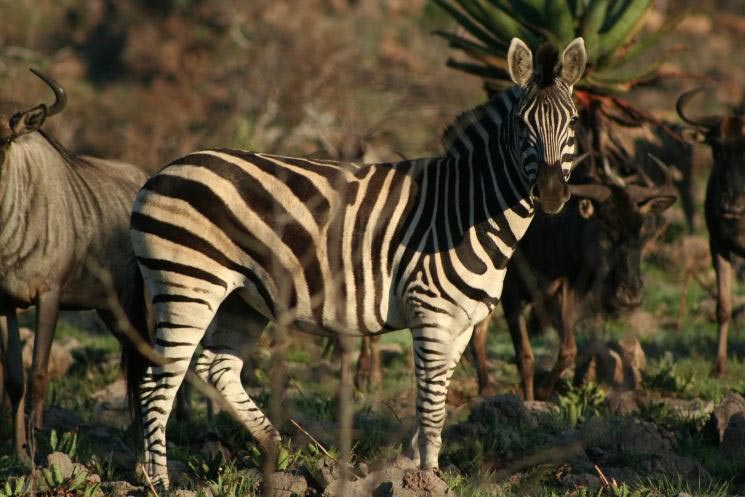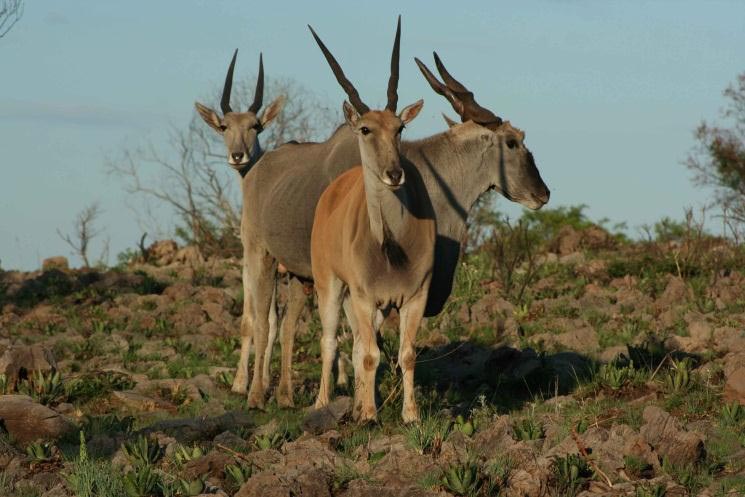When Mr Abraham Kruger bought the farm in 1967 it was a cattle farm. Over the years large game has been introduced back into the area. The first to arrive were the blue wildebeest, zebra and blesbuck. As these animals numbers increased, some were caught and swapped for other animals like eland, red hartebeest, kudu and impala. Other animals include; jackal, baboon, monkeys, porcupine and smaller buck species.

Blue Wildebeest
These are our most commonly seen game. They often come and graze on the front lawn in the evenings and when it is overcast. Both sexes have horns and are dark grey with black mane and tail. They can weigh up to 180kg and live for up to 20 years. The young wildebeest are a light brown colour to camouflage them in the dry grass.

Zebra
These stocky, pony-like wild horses have black-and white stripes, with patterns unique to each animal. At Hoogland zebras are normally found in pairs, sometimes forming herds for short periods of time.

Eland
Eland are the biggest antelope in Africa with males reaching up to 900kg. They are docile animals and very often seen on the walks. At the moment we have three distinct herds, but this varies through the year. The males tend to be a darker colour with shorter horns than the females. As they get older the light brown coat becomes greyer and darker.
Southern Porcupine
Because these animals are strictly nocturnal they are very rarely seen. Their quills, signs of foraging and cigar shaped droppings are the best indicators that they are in the area. They have long black-and-white banded quills on their hind halves and coarse dark hair on the rest. The cave on the other side of ‘Dolomiet’ has been home to a family of porcupines for many years.
Scrub Hare
These hares are nocturnal and often seen when driving after dark. There have been sighting on the walks as well. Their upper-parts have brown-grey grizzled hair, while the under-parts tend to be bright white.
Egyptian Free-tailed Bats
These are the most common bats in the area, with a big colony occupying the large cave. If you are visiting the cave just after sunset clouds of bats can be seen exiting the cave to feed. They have a coat of short, dark brown velvety hair. One bat can eat more than a 1000 mosquitos in a night. They are harmless to people.
Steenbok
This buck is very rarely seen. It is small (only 50cm from ground to shoulder) and at first sight of trouble it will lie down low in vegetation. They are a fawn colour with white under-parts. Only the ram carries horns.
Baboon
These large primates can weigh up to 45kg. The have grey-brown coats and the upper surfaces of their hands and feet are dark brown to black. They tend to make a nuisance of themselves around the building. It is important to keep your windows and outside doors closed when not in the room during the day. Fortunately they are not active at night.
Vervet Monkeys
These monkeys are very rarely seen when the baboons are around. They tend to be a bit more skittish than the baboons, but will still take advantage of free food in an open room. Look out for these grizzled-grey animals around the building.
Black-backed Jackal
These fox like animals are more often heard than seen. The screaming yell is heard regularly in the early evenings. They are a reddish brown with a distinct black and while saddle across the back and shoulders.
Yellow Mongoose
These mongooses are most often seen running across the road. They are reddish-yellow to tawny-yellow in colour, with a total body length of 40-60cm. Their bushy tails are kept parallel to the ground when walking and 45° when running.
Meerkat
This small mammal is part of the mongoose family. Sighting of this animal has increased in the last few years. Their bodies are fawn to silvery-grey. They commonly stand on their hind legs to look out for predators. Mostly seen while running across paths.
Rock Hyrax (Dassie)
Dassies are often seen sitting on rocks around the ‘Amphitheatre’. They are small stoutly animals with short legs and no tails. Their thick fur tends to be grey-brown. Their closest living relative is the elephant.
Red Hartebeest
These are the shyest of our big game. They are reddish brown with a black tail and blaze down the front of the face. Their horns are set close together at the base but curve forwards and out towards the top
